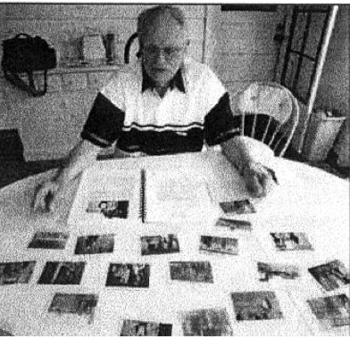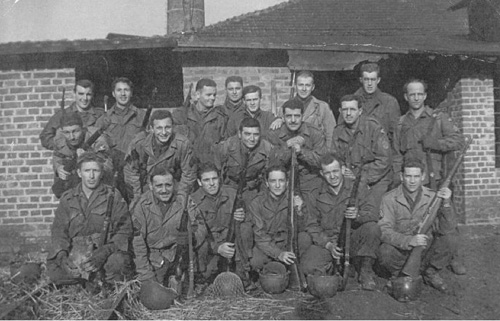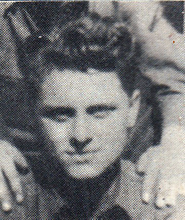BIO:
Vernon Wesley Tott was born 22nd December 1924, in Orange City, Iowa, to Hubert and Nellie (Notebone) Tott.
Vernon was one eleven children. He attended West Junior and Central High leaving in the eleventh grade to join the army. Vernon received his GED in 2001 in a ceremony honoring servicemen who did not graduate.
I was drafted into the army, March 1943. I had basic training was in Camp Roberts near Bakersfield, California, for thirteen weeks. Then I was sent to Camp Clayborn, Louisiana, and joined the 84th Infantry Division. We trained for about a year and then we shipped out to New York City and joined a large convey of ships to cross the Atlantic Ocean to Liverpool, England. From there we were sent to Southampton, England, and crossed the English Channel to Omaha Beach about six weeks after the invasion. From there, we fought the Germans through Holland, Belgium and Germany till we met up with the Russians by Berlin.
We not only had to battle the Germans we had to battle the cold weather and deep snow. We went from November to May wearing the same clothing and no baths and not many hot meals. We all suffered and we saw a lot of suffering and killing. We lost 6000 troops. We saw many Germans - women and children that were killed by our bombing. The people that suffered the most were the Jews in all
of Europe. Hitler killed and starved to death, 6 million Jews.
Our 84th Infantry Division liberated two Jewish slave labor camps and what we witnessed was unbelievable.
On 10 April 1945, we were going to attack Hanover, Germany. Early that morning I was sitting at a crossroad west of Hanover and after the sun came up we could see down a dirt road that someone was waving at us. We thought they were American POW’s so we went to them.
When we got there, we could see that it was a Jewish slave labor camp – called Ahlem. What we saw there was so horrendous that it made us soldiers sick to our stomachs and even cry. We were witnessing Hell on Earth. It was hard to believe that Hitler and the SS could treat people like this. The first thing we saw was a pile of dead bodies and the few prisoners alive were skin and bone. We went into their barracks and there were many lying in bunks to sick and to weak to get up. It was so horrible – I never saw anything like this. I had a vest pocket camera and I took 18 pictures there to send home to my family. These pictures laid in my basement for 50 years.

Our 84th Infantry Division has a reunion every year since WW2 and we get a newsletter three times a year. In our March 1995 newsletter, there was an article in it from Benjamin Sieradzki. He was a prisoner in this camp and he was looking for the soldier that took pictures there on liberation day. I knew he was looking for me because I was the only soldier that took pictures that liberation day. I called him and sent copies of the pictures to him. He called me back and he was in my pictures. He couldn’t believe that after 50 years he found me. He was near death and he had lost all of his family. He was in a hospital over a year to get his health back. He came to the USA in 1953 and he became an engineer. When they built the Iowa Beef Plant at Dakota City, Nebraska, he was the head engineer on the equipment that went into this plant. At that time, I was the beef kill foreman for Swift and Co. in Sioux City and in 1968, we had to close down because we couldn’t compete with this modern plant Benjamin Sieradzki help build. I told Benjamin that the 17 year old boy that I took a picture of in this slave labor camp – had cost me my job in 1968. Benjamin told me that these pictures were priceless to him and he thanked me over and over for them. He was so thankful to me for copies of the pictures I though I should try and find more of them that I took pictures of in this labor camp. There were 1000 Jews in this camp at first and I saw only about 40 alive there. It’s a very long story but now I have found 27 Jewish survivors of Ahlem and 13 of them are in my pictures. They call me their angel – their godfather for finding them and bringing them back together again.
They all had a horrible story to tell about how they lost all of their family. Most of them came to the USA and became very successful. One worked for our space agency and invented parts for the moon landing. Another invented and marketed the first home computer, Commador 64, and invented the Atari video games.
August 1998, our 84th Infantry Division had a reunion at Albany, New York and nine of these Jewish survivors I found came to that reunion. I gave a speech in a large ballroom and I had these survivors of Ahlem give a speech too, to thank the 84th Division for liberating them and putting them into a hospital. There were many news people there and NBC was there and taped my program and Tom Brokaw put my story on national TV news, November 1998. After that the Associated Press came to my home and interviewed me and put my story in newspapers all over the world.
When the people of Hanover, Germany, heard about me having pictures of these horrible camps and I was an eyewitness and found 27 Jewish survivors of Ahlem. I got many letters and phone calls from them. I got letters from museums, University of Hanover, historians and writers. I got a phone call from a Video Production Co. in Germany and they came to the USA and interviewed me along with the survivors of Ahlem whom I found. They wanted this for their archives.
They built a memorial at the Ahlem campsite in 1994, and they had Henry Kissinger, our former Secretary of State, give a speech there when they dedicated the memorial. Henry Kissinger saw this camp, too, he was in our company in the 84th Division. I was invited to come to Hanover, Germany, 1 May 2001, and asked to bring three Jewish survivors with me. They had us speak to many school students there. They built a new memorial at the Ahlem Campsite with the names of the Jews who died there and on 8 May 2001, they had me give a speech there when they dedicated this new memorial.
I was discharged from the Army, January 1946, and worked for Swift & Co. for 37 years as the Beef Kill Floor Foreman.
I got married in July 1947, and had two children, Richard and Nancy. I remarried in November 1974 to Betty Shaver and she had three children, Vicky, Donna, and John.
I received the Combat Infantry Badge, Bronze Star, three Battle Stars and a Regiment Citation for the Battle of the Bulge.

From left to right, front row: Richard G. Thomas of Seattle WA, Ralph A. Mangle of Atlanta GA, Edward Mesher of Cliveman OH, Russell L. Lowe of Shepponsville PA, Barney W. Upchurch of Los Angeles CA, Harvey West of Crisson TX. Second row: Woodrow B. Sanders of Oklahoma City Okla, Emanuel Mandlekern of NYC, Capt Carl Reed of Bridgeport TX, Antonie Sharbare of Weed CA, Emile Dubois of Nashua NH, Paul Lodes of Okarche OK. Third row: Clayton Kemp of Milton MA, Frank Balsbaugh of Harrisburg PA, Richard Daugherty of Rockville IN, Vernon W. Tott of Sioux City IA, William J. Keating of Chicago IL, and Russell Leaming of York NE.
Written and submitted by Vernon W. Tott.
![]()

